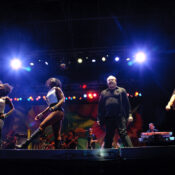George Gershwin’s “Rhapsody in Blue” turns 90 years old this week, and is barely showing its age. It remains as appealing and as fresh as it did at its 1924 premier, when it helped earn jazz a new degree of respect from America’s music critics.
Jazz was still quite young that year. It had only just emerged in the previous decade as African American composers began blending blues, folk music, popular ballads, and ragtime into a new musical form. For several years, jazz incubated in the juke joints, saloons, and nightclubs of New Orleans, building a following among the working classes and black community. Finally, in 1917, the Victor Talking Machine Company issued a recording of “Livery Stable Blues.” It was, many will argue, the first recording of jazz. It was also one of the first records to sell one million copies.
Despite the popularity of this, and the hundreds of jazz records that followed, jazz drew nothing but scorn from the voices of America’s cultural establishment: music critics, composers, conductors, and self-appointed moral guardians. But jazz became increasingly hard to ignore as young Americans were captivated by its bright, energetic sound. An entire generation, it seemed, was learning to play the saxophone, and the omniscient strains of the “Charleston” and “Black Bottom” were heard from urban night clubs to college campuses as the country entered its “Jazz Age.”
When the critics finally deigned to review jazz, they tended to favor adjectives like “barbaric” and “degenerate.” Jazz was, they said, “the product of incompetents,” and “a species of music invented by demons for the torture of imbeciles.” And some critics reminded readers that jazz was the creation of black musicians, which—for them—implied all manner of vices.
Yet jazz continued growing in popularity and sophistication. Musicians were taking the form into new areas, developing unique sounds and experimenting with new styles and instrumentation.

One of the people helping to develop jazz was Paul Whiteman. In 1922, this popular bandleader was earning over $1 million a year conducting several jazz bands on the East Coast. He became so closely associated with the new musical form that he was called “The King of Jazz” (a term, by the way, he knew he didn’t deserve.)
And he became the target of criticism from the reviewers and music ‘experts’ who despised jazz.
Hoping to appease his critics, Whiteman proposed an all-jazz concert to be held at a classical-music venue, New York’s Aeolian Hall. The idea was not greeted with general enthusiasm. Whiteman later told the Post, “Some of the musicians I most admired, who had until then regarded me with a slightly amused but tolerant air, now talked themselves red in the face about the insolence of “jazz boys” who wanted to force their ridiculous efforts upon the world.”
Whiteman thought these critics might drop their objections to jazz if they heard how much it had evolved in recent years. “I believed that most of them had grown so accustomed to condemning the ‘Livery Stable Blues’ type of thing that they went on flaying modern jazz without realizing that it was different from the crude early attempts.”
Yet he couldn’t shake the fear that his concert would antagonize the critics even further. The musical establishment was slow to change. After all, he told the Post, “We were trying to get a favorable hearing from the most hidebound creatures in the world–educated musicians. It was educated musicians who scorned Wagner, resisted Debussy, and roasted Chopin.”
So when the afternoon of the concert arrived, Whiteman was pacing nervously backstage. He already knew he would lose almost half the money he had sunk into the concert, and there was no telling how his reputation would suffer if the critics panned the performance.
“Fifteen minutes before the concert was to begin I yielded to a nervous longing to see for myself what was happening out front…I slipped round to the entrance of Aeolian Hall. There I gazed upon a picture that should have imparted new vigor to my wilting confidence. It was snowing, but men and women were fighting to get into the door, pulling and mauling each other as they do sometimes at a baseball game, or a prizefight, or in the subway. Such was my humility by this time that I wondered if I had come to the right entrance.”

By 5:30p.m., he knew he had been in the right place with the right idea. Several critics came up to him when the concert was over to congratulate him. Some critics still remained unmoved, but others praised the entire performance, particularly its “first rhapsody written for a solo instrument and a jazz orchestra”—”The Rhapsody In Blue.”
It’s hard to believe that this masterpiece was created so haphazardly. Gershwin composed it in one month in-between writing music for Broadway musicals. He handed it to Whiteman’s arranger, Ferde Grofe, on February 4, which left only one week for the parts to be orchestrated and rehearsed. Moreover, the score Gershwin handed over wasn’t even complete.
The Rhapsody included several virtuoso passages for the piano that, at the time of performance, only existed in Gershwin’s head. At one point, when he played solo, he simply left a blank space in the score, indicating the orchestra was to remain silent. The only cue Whiteman had to prompt the orchestra to start playing again was a note in the score telling him to wait until he saw Gershwin nod his head.
Grofe thought the Rhapsody’s middle passage was weak, and told Gershwin it needed some additional music as a bridge between themes. Gershwin hunted around, and then found the score for a song he had been saving for a musical and hurriedly worked it in.

Even during rehearsal, Gershwin was still adding touches that contributed to the Rhapsody’s success. One of its most memorable passages is a long sliding rise of the clarinet in the opening measures.
During rehearsal, when the clarinettist in Whiteman’s band practiced this passage, he jokingly gave it a slurred, bluesy glide, making the clarinet rise into a wail. He had intended it as a joke, but Gershwin latched onto the sound and asked the clarinet player to repeat, and even exaggerate, that wail at the performance.
Whiteman had wanted his concert to prove that jazz no longer relied on improvisation. But Gershwin’s successful creation of the Rhapsody showed that a successful jazz artist must always be ready to respond instantly to new ideas, to discard the work of months to capture the genius of a moment.
Become a Saturday Evening Post member and enjoy unlimited access. Subscribe now





Comments
Rhapsody in Blue is one of my favorite pieces of music EVER! The first time I played my mother’s 78 rpm record, I played it 20 times, and those opening measures still thrill me so. Great article.
Ug. I mean did the Post ever publish anything about them.
Thanks for the article, Jeff. My great grandmother played clarinet, saxophone and sousaphone in an “all-girls” jazz band from 1925 until well into the Great Depression. I have many of her glamorous stage photos. Surprisingly, there were a lot of these female bands. Did the Post ever right anything about them? Thanks.